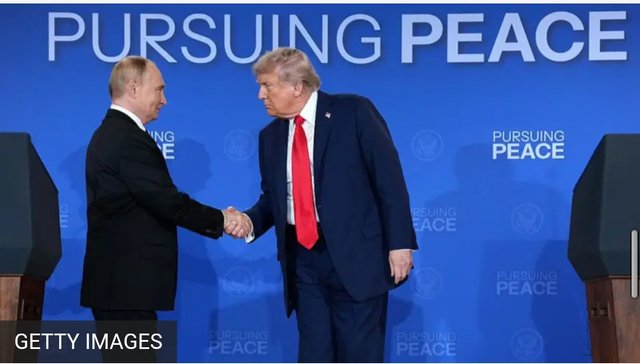Next Time in Moscow? Five Key Takeaways from the Trump-Putin Summit in Alaska
The high-stakes meeting between U.S. President Donald Trump and his Russian counterpart Vladimir Putin was presented as a crucial step toward peace in the war in Ukraine.
But without a cease-fire, and with an invitation to Moscow, the nearly three-hour meeting between the two leaders raised more questions than it answered.
Here are five key takeaways from the Alaska summit:
- Putin welcomed back onto the international stage with a red carpet.
When President Vladimir Putin returned to the international stage on Friday, the skies were cloudy in Alaska. U.S. President Donald Trump awaited him, with a red carpet rolled out on the tarmac of Elmendorf-Richardson Joint Base.
As Putin approached, Trump applauded. The two leaders shook hands warmly and smiled.
It was a remarkable moment for Putin, a leader shunned by most Western countries since Moscow launched its full-scale invasion of Ukraine in 2022. Since then, his international trips have been largely limited to friendly nations such as North Korea and Belarus.
The mere fact that the Alaska summit took place was already a victory for Putin. But the welcome he received exceeded the Kremlin’s wildest dreams. In just six months, Putin went from being a pariah in the eyes of the West to an honored guest on American soil, greeted as a partner and friend.
To top it off, in an apparently spontaneous move, Putin agreed to ride to the air base in Trump’s armored limousine instead of using his own Moscow-registered presidential car.
As the vehicle pulled away, cameras zoomed in on Putin, laughing in the back seat.
- Putin confronted with questions he had never faced before.
Over his 25 years in power, Putin has tightened his grip on Russian media, crushing press freedom and replacing news with propaganda. In Russia, he is rarely, if ever, confronted by hostile journalists.
Yet just minutes after landing in Alaska, a reporter shouted at him: “Will you stop killing civilians?” If the question unsettled him, he didn’t show it—he simply shrugged and looked away.
During a brief and somewhat chaotic photo session, other questions followed, including one in Russian asking whether Putin would be willing to meet with President Volodymyr Zelensky for a trilateral summit. Once again, the Russian leader showed no visible reaction, except for a faint, enigmatic smile.
- What was said when the talks ended earlier than expected.
Journalists around the world gathered in the room with Putin and Trump expected a press conference. Instead, both leaders made short statements and took no questions.
In an unusual move, Putin spoke first. He praised the “constructive atmosphere of mutual respect” in the “friendly” talks, before launching into a short history of Alaska as Russian territory.
While Putin spoke, Trump remained silent. It took several minutes before the Russian president mentioned what he called the “situation in Ukraine,” apparently the main reason for the summit. When he did, it was to declare that, although some unspecified “agreement” had been reached, the “root causes” of the conflict needed to be eliminated before peace could be restored.
That phrase likely set off alarm bells in Kyiv and beyond. Since the war began, it has been code for a series of maximalist demands—seen as impossible by Ukraine—including recognition of Russian sovereignty over Crimea, Donetsk, Luhansk, Zaporizhzhia, and Kherson; Ukrainian demilitarization and neutrality; no foreign military involvement; and fresh elections. In short, it amounts to capitulation—unacceptable for Kyiv, but still Moscow’s priority after three and a half years of bloody conflict.
It was clear there would be no deal.
- And what was left unsaid.
Remarkably—given the summit’s context and purpose—when Trump spoke, he did not once mention Ukraine or the possibility of a cease-fire. He merely noted that “five, six, seven thousand people a week” were being killed, and that Putin also wanted to see an end to the bloodshed.
Trump, usually verbose, had less to say than Putin. His statement stood out for its unusual brevity—and vagueness. “We agreed on many points,” Trump said, adding that “considerable progress” had been made in an “extremely productive meeting.”
But he gave no details, and no concrete steps appeared to have been taken toward resolving the Ukrainian conflict. No major agreements, nor any trilateral meeting with President Zelensky, were announced.
And, to Moscow’s relief, there was no mention of the “serious consequences” Trump had previously threatened if no cease-fire was reached.
“We didn’t get there,” Trump admitted.
Then, with vague optimism, he added: “But we have a very good chance of getting there.”
- Next time in Moscow—Putin makes a rare remark in English.
The summit may not have delivered tangible progress toward peace in Ukraine, but it cemented a thaw in U.S.-Russia relations.
Photos of the two presidents shaking hands repeatedly and smiling spread widely across social media, as did images of U.S. servicemen kneeling to roll out the red carpet beneath Putin’s plane.
Before concluding his remarks, Putin echoed one of Trump’s frequent claims—that the war in Ukraine would never have started if Trump had been in office.
Despite Trump’s insistence that “considerable progress” had been made, nothing concrete emerged from the Alaska summit. Still, both leaders left the door open to another meeting—this time on Russian soil. “I will probably see you very soon,” Trump said.
At the end of a joint statement that required no promises, concessions, or compromises from him, Putin may have felt comfortable enough to switch briefly to English—a rarity. Laughing, he looked at Trump and said: “Next time, in Moscow.”
“Oh, that’s interesting,” Trump replied. “I’ll take some heat for it, but I think it’s quite possible.”
